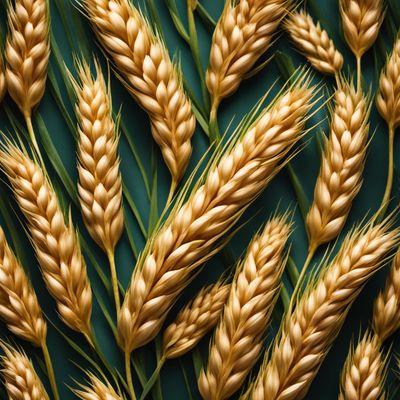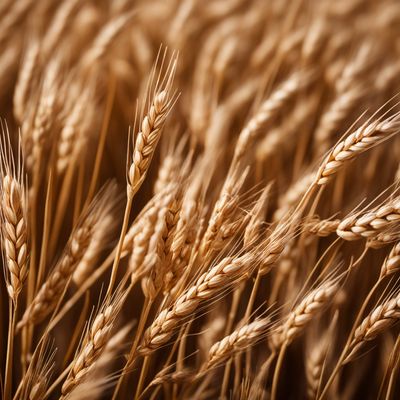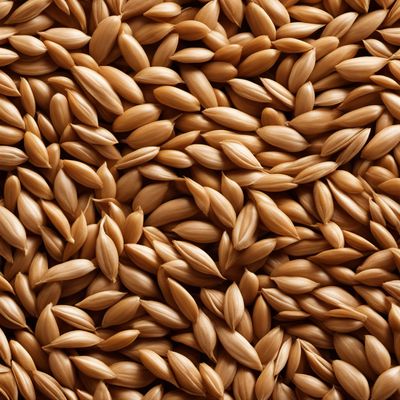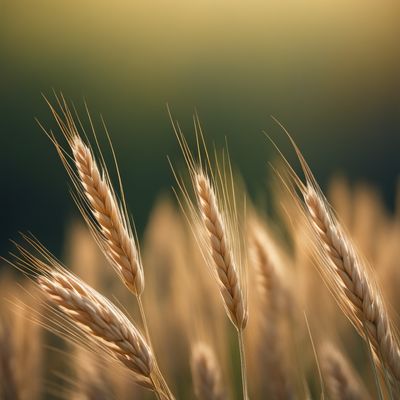
Ingredient
Common wheat grain
The Versatile Staple: Common Wheat Grain
Common wheat grain is a cereal grain that belongs to the Triticum aestivum species. It is the most widely cultivated type of wheat worldwide and is primarily used for making flour. Common wheat grain has a hard outer shell, or bran, which is removed during the milling process to produce white flour. The inner part of the grain, known as the endosperm, is ground into flour and used in baking. It has a mild, slightly nutty flavor and a chewy texture when cooked. Common wheat grain is a versatile ingredient that can be used in a wide range of dishes, from bread and pasta to cookies and cakes.
Origins and history
The cultivation of wheat dates back thousands of years, with evidence of its domestication found in ancient civilizations such as Mesopotamia and Egypt. Common wheat grain originated in the Fertile Crescent, a region encompassing modern-day Iraq, Syria, Jordan, Lebanon, and Israel. It played a crucial role in the development of agriculture and the rise of civilizations in these areas. Today, common wheat grain is grown in various countries around the world, with major producers including China, India, Russia, and the United States.
Nutritional information
Common wheat grain is a good source of carbohydrates, dietary fiber, and essential minerals such as iron and magnesium. It also contains small amounts of protein and B vitamins. However, the nutritional composition can vary depending on the processing and refinement of the grain. Whole wheat grain, which includes the bran and germ, is more nutritious than refined white flour.
Allergens
May contain gluten allergens.
How to select
When selecting common wheat grain, look for grains that are plump, firm, and free from any signs of moisture or insect damage. Avoid grains that appear shriveled or discolored, as these may indicate poor quality or spoilage. Opt for packaged grains that are labeled as whole wheat" or "whole grain" to ensure you are getting the most nutritional benefits."
Storage recommendations
To maintain its freshness and prevent insect infestation, store common wheat grain in an airtight container in a cool, dry place, such as a pantry or cupboard. Avoid exposing it to moisture or direct sunlight, as this can cause the grain to spoil or lose its quality. Properly stored, common wheat grain can last for up to a year.
How to produce
Common wheat grain is typically grown on a large scale by professional farmers using specialized equipment and techniques. However, if you have a spacious garden or access to agricultural land, you can attempt to grow common wheat grain. It requires well-drained soil, ample sunlight, and regular watering. Consult with a local agricultural extension office or farmer for guidance on the specific cultivation practices and harvesting process.
Preparation tips
Common wheat grain can be cooked and used in various recipes. To cook the grain, rinse it thoroughly under cold water to remove any debris. Then, combine the grain with water or broth in a saucepan and bring it to a boil. Reduce the heat, cover, and simmer for about 15-20 minutes or until the grains are tender and have absorbed the liquid. Cooked wheat grain can be used as a base for salads, added to soups or stews, or used as a side dish. It can also be ground into flour and used in baking recipes such as bread, muffins, or cookies.
Substitutions
Spelt grain, Kamut grain
Culinary uses
Common wheat grain is a versatile ingredient used in a wide range of culinary applications. It is primarily used for making flour, which is then used to bake bread, rolls, pastries, and pasta. It can also be cooked and used as a side dish, added to soups or stews, or used as a base for salads. In some cuisines, common wheat grain is sprouted and used in salads or as a topping for sandwiches and wraps.
Availability
Worldwide
More ingredients from this category

Triticale grain
The Versatile Hybrid: Triticale Grain

Other species of genus Triticum, not elsewhere mentioned
Ancient Grains: Exploring the Lesser-Known Triticum Varieties

Spelt grain
The Ancient Nutritious Grain

Einkorn wheat grain
Ancient Grains Rediscovered: Einkorn Wheat

Emmer wheat grain
The Ancient Grain: Emmer Wheat

Tritordeum
The Golden Grain: Unveiling the Wonders of Tritordeum

Durum wheat grain
The Golden Kernel

Khorasan wheat grain
The Ancient Nutrient

